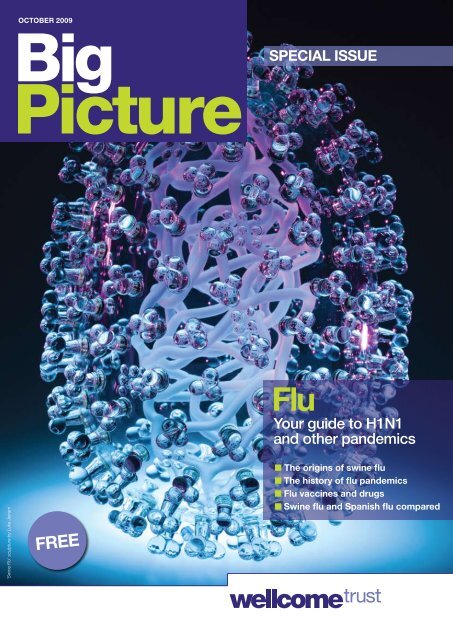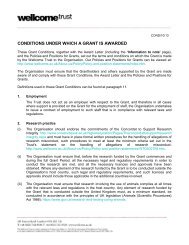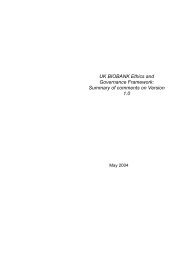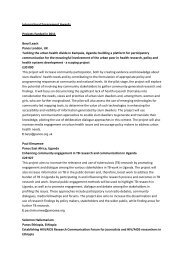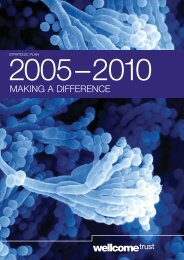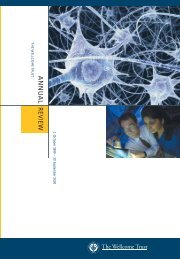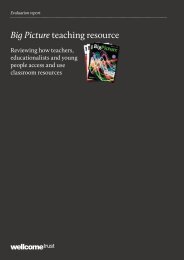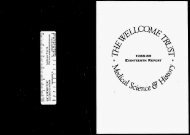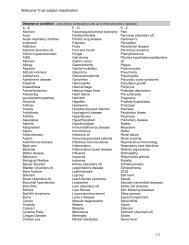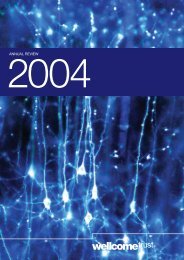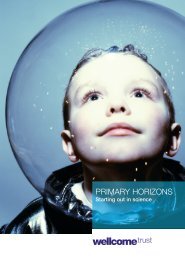Big Picture on Influenza - Wellcome Trust
Big Picture on Influenza - Wellcome Trust
Big Picture on Influenza - Wellcome Trust
- No tags were found...
Create successful ePaper yourself
Turn your PDF publications into a flip-book with our unique Google optimized e-Paper software.
<str<strong>on</strong>g>Big</str<strong>on</strong>g><str<strong>on</strong>g>Picture</str<strong>on</strong>g> October 2009<str<strong>on</strong>g>Big</str<strong>on</strong>g><str<strong>on</strong>g>Picture</str<strong>on</strong>g>Special ISSUEFluYour guide to H1N1and other pandemics'Swine Flu' sculpture by Luke JerramFREEn The origins of swine flun The history of flu pandemicsn Flu vaccines and drugsn Swine flu and Spanish flu compared
<str<strong>on</strong>g>Big</str<strong>on</strong>g><str<strong>on</strong>g>Picture</str<strong>on</strong>g><str<strong>on</strong>g>Big</str<strong>on</strong>g> <str<strong>on</strong>g>Picture</str<strong>on</strong>g> <strong>on</strong> influenzaA note <strong>on</strong> nomenclatureThe name of the 2009 pandemic has been c<strong>on</strong>troversial(see page 7) and is referred to by the World HealthOrganizati<strong>on</strong> as ‘pandemic (H1N1) 2009’. We have adoptedthe term ‘H1N1 swine flu’ for the 2009 pandemic and‘S-OIV’ (swine-origin influenza virus) for the virus that causes it.This special issue of <str<strong>on</strong>g>Big</str<strong>on</strong>g> <str<strong>on</strong>g>Picture</str<strong>on</strong>g> looks at what is knownabout H1N1 swine flu and how it compares with pastpandemics, seas<strong>on</strong>al flu and H5N1 avian flu. H1N1 swineflu was first detected in Mexico in February 2009. Ithas since spread rapidly to become the first influenzapandemic of the 21st century.The virus unmaskedThe influenza A virus is deceptivelysimple. At its core are eight shortstrands of RNA, the coding materialfor 11 proteins.The surface of the virus particle is studdedwith proteins, notably haemagglutinin (the‘H’ of H1N1) and neuraminidase (the ‘N’).Haemagglutinin is the structure that sticks thevirus to host cells; neuraminidase is an enzymethat clips off the sugars that haemagglutininbinds to, helping to release new virus particles<strong>on</strong> their way out of the cell.There are at least 16 different types ofhaemagglutinin (H1–16) and nine types ofneuraminidase. To date, <strong>on</strong>ly H1, H2 and H3viruses have infected large numbers of people.The M2 protein is an i<strong>on</strong> channel. The flowof i<strong>on</strong>s through this channel enables the virusto uncoat inside the cell, freeing the strands ofRNA to make new virus proteins.Neuraminidase (N)M2Haemagglutinin (H)Sebastian Kaulitzki/iStockphotoOut of c<strong>on</strong>trol?<strong>Influenza</strong> epidemics are almost impossibleto c<strong>on</strong>tain; the priority quickly becomesminimising their impact.Stopping an epidemic before it can becomeestablished could save many lives. That wasachieved with SARS (just) and has been the goalof H5N1 avian flu c<strong>on</strong>trol, but has not been possiblewith H1N1 swine flu.Initial c<strong>on</strong>tainment calls for highly effective surveillance, so a newoutbreak can be identified as rapidly as possible. Isolati<strong>on</strong> measures canthen be taken to c<strong>on</strong>tain infecti<strong>on</strong> and prevent escape of the virus. Massculling of birds in the H<strong>on</strong>g K<strong>on</strong>g poultry markets helped to c<strong>on</strong>tain earlybird flu outbreaks. Additi<strong>on</strong>al surveillance systems have been put inplace to m<strong>on</strong>itor for H5N1 outbreaks.So why did S-OIV slip beneath the radar? Important factors includepatchy m<strong>on</strong>itoring of influenza in pigs and the mildness of illness in mostpeople. Whereas a case of bird flu is likely to be picked up immediately,many cases of swine flu may have g<strong>on</strong>e unnoticed. In additi<strong>on</strong>, unlikethe H5N1 virus, S-OIV readily transmits between people.Within individual countries, health policy generally starts withc<strong>on</strong>tainment: identifying and isolating cases, tracing c<strong>on</strong>tacts andtreating with antivirals. More general hygiene measures are encouraged.People with known infecti<strong>on</strong>s are encouraged not to mix and affectedschools may be shut.Some countries m<strong>on</strong>itor visitors for signs of fever, but this is likely tohave little effect other than to delay an epidemic slightly.Once cases become widespread, c<strong>on</strong>tainment becomes impractical,and policy shifts to a mitigati<strong>on</strong> phase: trying to minimise the impactof an epidemic. This may mean special protecti<strong>on</strong> for the vulnerableand preparing for the expected waves of new cases. At this point,special measures are likely to kick in, as the health service implementspandemic plans. For example, n<strong>on</strong>-essential surgery may be put <strong>on</strong> hold.Other public health measures could be c<strong>on</strong>sidered, but muchdepends <strong>on</strong> the severity of the infecti<strong>on</strong>. Closing schools or banninglarge gatherings (such as football matches or c<strong>on</strong>certs) would bedifficult, disruptive and potentially ec<strong>on</strong>omically costly. If S-OIV were toturn more virulent, however, such measures might be taken to protectpublic health.2 <str<strong>on</strong>g>Big</str<strong>on</strong>g> <str<strong>on</strong>g>Picture</str<strong>on</strong>g>: Special Issue
Drugs and vaccinesClassical swineNorth AmericanavianHuman (H3N2)Eurasian swineDrugsAs S-OIV is a virus, antibiotics do not affect it. Antiviral drugsagainst influenza fall into two classes:neuraminidase inhibitors – such as oseltamivir (Tamiflu) andzanamivir (Relenza) – which target the neuraminidase enzymeadamantanes – such as amantadine – which act <strong>on</strong> M2.Neuraminidase inhibitors have fewer side-effects and are moreeffective. They are not cures: they shorten flu episodes by a coupleof days, reduce the risk of complicati<strong>on</strong>s and possibly lower thelikelihood that some<strong>on</strong>e will pass <strong>on</strong> the virus. Ideally, they shouldbe given as early as possible in an infecti<strong>on</strong> and can also be usedprophylatically (to prevent infecti<strong>on</strong>).Resistance to oseltamivir has been detected in seas<strong>on</strong>al H1N1strains, and in most countries resistant strains now predominate.S-OIV is resistant to amantadine but usually susceptible t<strong>on</strong>euraminidase inhibitors; some cases of oseltamivir resistance havebeen seen. Oseltamivir resistance has been seen in some humancases of H5N1 avian flu.Because of the risk of resistance, it is much better to use drugs incombinati<strong>on</strong>. Other flu drugs are in development but years away fromhuman use.Vaccines<strong>Influenza</strong> viruses evolve rapidly, so new vaccines are frequentlyupdated to match viral strains in circulati<strong>on</strong>.To deal with seas<strong>on</strong>al flu, the World Health Organizati<strong>on</strong> m<strong>on</strong>itorsstrains circulating in the southern hemisphere and the tropics duringits winter and predicts which are most likely to hit the northernhemisphere later in the year. Vaccine manufacturers take thesepredicti<strong>on</strong>s and, in a race against time, develop and test new vaccines.Each vaccine covers two influenza A strains and <strong>on</strong>e B strain. Sixm<strong>on</strong>ths later, the process is repeated for the southern hemisphere.Traditi<strong>on</strong>ally, vaccines have been grown in chicken eggs, but new,more efficient cell culture systems are now beginning to be used.If a vaccine is a close match for the strains that eventually dominate,it will give better protecti<strong>on</strong>. If the circulating virus changes more thanexpected, or a minor strain becomes unexpectedly comm<strong>on</strong>, thevaccine will be less effective. Protecti<strong>on</strong> is typically effective in 60–80per cent of cases (lower in elderly people, who tend to have weakerimmune systems).Vaccine resp<strong>on</strong>ses can be enhanced by adjuvants – chemicals that‘turbocharge’ immune resp<strong>on</strong>ses. This is a way to eke out vaccinesupplies, as lower doses of the viral haemagglutinin could be used(‘antigen sparing’).Most valuable would be a vaccine that recognised all influenzastrains. One such ‘universal’ vaccine, targeted at the less rapidlyevolving M2 protein, has been successfully tested in animals. ‘Viruslikeparticles’ c<strong>on</strong>taining a mix of flu proteinshave also shown promising results in animalstudies.Researchers are working <strong>on</strong> new types ofvaccine, including those that recognise allstrains of influenza. These are several yearsaway from human use, however.S-OIVH1N1 flu viruses are in c<strong>on</strong>stant circulati<strong>on</strong>,but S-OIV is different: it c<strong>on</strong>tains bits of bird,pig and human influenza viruses.Analysis of its genetic make-up suggests that it firstappeared sometime between autumn and Christmas 2008,so was almost certainly circulating before it was first detectedin Mexico.Where it first made the leap from pigs to humans is unclear;its closest relative in pigs is a H<strong>on</strong>g K<strong>on</strong>g sample from 2004.However, this is a ‘cousin’, distantly related to S-OIV, so itcannot be said with certainty where S-OIV emerged. Asia maybe a ‘hotspot’ for jumps across species as large numbers ofpeople live close to livestock such as pigs and poultry. China,for example, accounts for half the world’s pig c<strong>on</strong>sumpti<strong>on</strong> –around 1.2 milli<strong>on</strong> pigs every day.Pandemic influenza phasesPHASES 5–6PANDEMICThe eight strandsof the S-OIV genomehave come from avariety of influenzaviruses.Where has it come from?From Neumann G et al. Nature 2009;459:931–9.The merits of ferretsIn 1933, ferrets being used in work <strong>on</strong> adistemper vaccine c<strong>on</strong>tracted influenza froma researcher (and also managed to pass it<strong>on</strong> to another). The researchers identifiedinfluenza virus and since then the ferret hasbeen used as a model of human flu – theyshow similar symptoms and a similar patternof virus receptors al<strong>on</strong>g their respiratory tract(unlike mice). They have been used tounderstand more about flu and to testnew vaccines.TIMEPHASES 1–3Predominantlyanimal infecti<strong>on</strong>s:few humaninfecti<strong>on</strong>sPHASE 4Sustainedhumanto-humantransmissi<strong>on</strong>Widespreadhuman infecti<strong>on</strong>POST-PEAKPossibilityof recurrenteventsPOST-PANDEMICDisease activityat seas<strong>on</strong>allevelsPandemic: A pandemic is a worldwide epidemic of a disease. The WorldHealth Organizati<strong>on</strong> formally categorises outbreaks into different phases.A global pandemic of H1N1 swine flu was announced <strong>on</strong> 11 June 2009.World Health Organizati<strong>on</strong>Eric Isselée/iStockphotoOctober 2009 3
<str<strong>on</strong>g>Big</str<strong>on</strong>g><str<strong>on</strong>g>Picture</str<strong>on</strong>g>The past and presentH1N1 swine flu shares features with seas<strong>on</strong>al flu and past pandemics.Flu viruses spread quickest in cool, dry c<strong>on</strong>diti<strong>on</strong>s typical of winter(when people are also more likely to be close together indoors). Otherthan the likelihood that swine flu will strike hard during winter 2009–10,little can be said with certainty about its future impact.Anna Tanczos1918 flu virusThe 1918 flu virus has been revived – and is helpingto explain why flu can be so deadly.SPLFlu through history1890: Russian flu (H3?) kills 1 milli<strong>on</strong>1918: Spanish flu (H1N1) kills 40–50 milli<strong>on</strong>1957: Asian flu (H2N2) kills 100 000–2 milli<strong>on</strong>1959: H5N1 bird flu kills two flocks of chickens inScotland (but does not infect people)1968: H<strong>on</strong>g K<strong>on</strong>g flu (H3N2) kills 700 000–1 milli<strong>on</strong>1976: Fort Dix swine flu outbreak; <strong>on</strong>e death,40 milli<strong>on</strong> Americans inoculated1997: H<strong>on</strong>g K<strong>on</strong>g H5N1 outbreak; six human deaths2003: First post-H<strong>on</strong>g K<strong>on</strong>g H5N1 deaths2009: H1N1 swine flu detected in MexicoWhere next?What might be the next step in theswine flu pandemic?It is unnerving that most of the previous flu pandemics, includingSpanish flu, have occurred in waves, sometimes with later wavesbeing more severe than earlier <strong>on</strong>es.However, this is not necessarily an inherent feature of flu pandemics.Since S-OIV is new to human hosts, it is likely to change as it circulates,but in ways that are hard to predict.The success of a virus lies in its ability to make more copies of itself andspread. Mutati<strong>on</strong>s that increase these abilities will be selected for andthrive. A mutati<strong>on</strong> that increases the severity of infecti<strong>on</strong> may not actuallyhelp the virus in the l<strong>on</strong>g run: if it rapidly kills its host, it may reduce itschances of being passed <strong>on</strong> (see page 6).The Spanish flu virus disappeared from circulati<strong>on</strong> many years ago, leavingunexplained the reas<strong>on</strong>s for its severity. In 2005, however, a US team tracked downan Alaskan flu victim who had been buried in permafrost since November 1918, thenrec<strong>on</strong>structed from scratch the 1918 virus.The reborn virus is lethal to mice, and grows rapidly in human cells; it infects butdoes not kill pigs. Although re-creating a lethal virus might seem risky, studies ofthe 1918 virus have told us much about the effects of different flu proteins and howthe virus spreads (see page 6). Studies are carried out in specialised c<strong>on</strong>tainmentfacilities to prevent the virus escaping.With the 1918 virus available, systematic studies can be d<strong>on</strong>e, with artificial virusesc<strong>on</strong>taining different combinati<strong>on</strong>s of 1918 and ‘modern’ genes. Such studies havehelped to reveal the key role of the HA, NA and PB1 genes from the 1918 virus.HA c<strong>on</strong>ferred the ability to infect human cells with high efficiency. Because NA andHA come from an avian virus, they are more compatible and work well together.PB1 and other genes c<strong>on</strong>tributed to the severity of infecti<strong>on</strong>.Equitable accessWho will gain access to aninfluenza virus vaccine?When a swine flu vaccine becomes available,almost every<strong>on</strong>e in the UK is likely to be offereda vaccine. In less developed countries,people may not be so lucky.Amid the rush to order and make anH1N1 swine flu vaccine, the WorldHealth Organizati<strong>on</strong> (WHO) has urgedmanufacturers to c<strong>on</strong>sider the plightof developing countries. The largestmanufacturer, Sanofi-Aventis, haspledged to d<strong>on</strong>ate 10 per cent ofvaccine output (100 milli<strong>on</strong> doses) tothe WHO, while GlaxoSmithKline hasoffered 50m doses. A third key producer,Novartis, has declined to d<strong>on</strong>ate for free buthas offered to supply vaccine at a discount.The WHO is also encouraging countries tod<strong>on</strong>ate vaccine and funds to support distributi<strong>on</strong>.Because of other health problems, such as HIV, malaria, TB andmalnutriti<strong>on</strong>, H1N1 swine flu could have a substantially greater impact<strong>on</strong> poor countries.In reality, gaining access to vaccines is not the <strong>on</strong>ly obstacle tomass vaccinati<strong>on</strong>. Many developing countries have little medicalinfrastructure through which to deliver vaccines. The likelihood is thatthey will be available <strong>on</strong>ly for key groups such as healthcare workers.4 <str<strong>on</strong>g>Big</str<strong>on</strong>g> <str<strong>on</strong>g>Picture</str<strong>on</strong>g>: Special Issue
Flu (seas<strong>on</strong>al, swine, avian and Spanish) and SARS comparedSeas<strong>on</strong>al flu 2009 Swine flu Avian flu 1918 Spanish flu SARSVirus type <strong>Influenza</strong> A and B <strong>Influenza</strong> A <strong>Influenza</strong> A <strong>Influenza</strong> A Cor<strong>on</strong>avirus<strong>Influenza</strong> subtype H1N1/H3N2 H1N1 H5N1 H1N1 –Route to humans Humans Pigs Wild birds via domesticatedbirdsTransmissibility Moderate High Human-to-humantransmissi<strong>on</strong> rareSymptomsFever, cough, aching,tiredness, sore throat,runny noseAs seas<strong>on</strong>al flu, sometimeswith diarrhoea or stomachupsetAs seas<strong>on</strong>al flu, plus fluidbuild-up in the lungs, severebreathing problems, chestpainsFrom astrology to chillsThe word influenza is derived from the Italianfor ‘influence’ – it was originally thought to haveastrological origins. This was later modified toinfluenza del freddo, ‘influence of the cold’. Theanglicised term influenza was first used in 1743.Birds, possibly via pigs ordirectlyHighAs avian flu, plus lungproblems and pneum<strong>on</strong>iaEstimated death rate 0.1% 0.1% or less 60% 2–20% 10%Bats via small mammalsModerateAs avian flu,plus pneum<strong>on</strong>iaDeaths (global) 250 000–500 000 (annual) 3555 (as at 10/9/09) 262 (as at 31/8/09) 50–100 milli<strong>on</strong> (total) 447 (total)Deaths (UK)At-risk groupsSummaryTypically 3000–4000; insevere years, up to 30 000Elderly, frail, those withheart and lung problemsor diabetesUnderappreciatedannual killer75 (as at 10/9/09) 0 250 000 0Infants, those with underlyinghealth problems, pregnantwomen; could change as virusevolvesWatch this space...AllExtremely nasty, but not yetspreading in peopleUnusual peak in deaths ofyoung adultsKilled more people thanWorld War IOlder adults, those withunderlying health problems‘We got lucky’: lowtransmissibility and drac<strong>on</strong>ianpublic health clampdownstamped it out before it couldspread widely© Bettmann/CorbisA very peculiar pandemicThe 1976 swine flu outbreak: the pandemicthat never was.On 5 February 1976, Private David Lewis at Fort Dixbarracks in New Jersey, USA, began to feel unwell. Within24 hours he was dead, victim of a virus last seen 58 yearsbefore: highly pathogenic H1N1 swine flu.Decisi<strong>on</strong>s had to be made fast. Could this be the birthof another pandemic, capable of devastating the USpopulati<strong>on</strong>? With the support of the medical community,by March President Gerald Ford (above) ordered anati<strong>on</strong>wide vaccinati<strong>on</strong> campaign, which C<strong>on</strong>gressapproved in August.By October, a new vaccine was ready. Almostimmediately there were problems. Three elderly people inthe Pittsburgh area suffered heart attacks so<strong>on</strong> aftervaccinati<strong>on</strong>. A surge of cases of Guillain–Barré syndromealso raised safety fears. In December the programme washalted, after 40 milli<strong>on</strong> doses had been given. No othercases of swine flu were detected.Rights and wr<strong>on</strong>gsThe story has provoked heated debate. Were the medicalestablishment and government wr<strong>on</strong>g to run with theprogramme? Yet if they had d<strong>on</strong>e nothing, and a pandemichad taken hold, the effects would have been catastrophic.Nowadays, decisi<strong>on</strong>-making processes are different.More tools are available, for example for surveillance andmodelling. And more phased approaches are used, allowingfor escalati<strong>on</strong> or fall-back as circumstances change.By stimulating interest in swine flu, the 1976 episode mayhave had <strong>on</strong>e other legacy. So<strong>on</strong> afterwards, a human H1N1virus reappeared – possibly an accidental laboratory release.It’s good to talkSwine flu has been characterised by opencommunicati<strong>on</strong> – unlike previous pandemics.In 1918, US President WoodrowWils<strong>on</strong> held an ir<strong>on</strong> fist <strong>on</strong> governmentcommunicati<strong>on</strong>s, which he believedwere vital to maintain morale.His adviser, Arthur Bullard, told him:“Truth and falsehood are arbitraryterms...There is nothing in experienceto tell us <strong>on</strong>e is always preferable tothe other...The force of an idea liesin its inspirati<strong>on</strong>al value. It mattersvery little if it is true or false.”Ignorance isn’t blissSo when the Spanish flu pandemic hitthe USA in September 1918, Wils<strong>on</strong>said nothing and public officials did littlebut utter reassuring words. Chicago’sdirector of public health c<strong>on</strong>cluded:“It is our job to keep people from fear.Worry kills more than the disease.”Newspapers toed the line, rarelyquesti<strong>on</strong>ing official pr<strong>on</strong>ouncements.In the absence of realisticinformati<strong>on</strong>, wild theories took off. Andpeople were scared. Communicati<strong>on</strong>systems came close to collapse.According to the Red Cross, people“were starving to death not for lack offood but because the well were toopanic stricken to bring food to the sick”.The current swine flu pandemic,by c<strong>on</strong>trast, has been played out in aremarkably public way. The outbreakin Mexico was world news almostimmediately. Internati<strong>on</strong>al and nati<strong>on</strong>alagencies have generally attempted tocommunicate rapidly and openly withthe public. Media reporting has, by andlarge, been resp<strong>on</strong>sible. In the daysof the internet, blogs and twittering,informati<strong>on</strong> cannot be easily c<strong>on</strong>tained.So far, there have been few signsof public panic. Another of WoodrowWils<strong>on</strong>’s advisers, Walter Lippman,told him that most citizens were“mentally children”. Perhaps the firstpandemic of the informati<strong>on</strong> agehas proved him wholly wr<strong>on</strong>g.• For more informati<strong>on</strong>, see‘Pandemics’, by John Barry(Nature, 21 May 2009).October 2009 5
<str<strong>on</strong>g>Big</str<strong>on</strong>g><str<strong>on</strong>g>Picture</str<strong>on</strong>g>Hit and runA flu infecti<strong>on</strong> can be unpleasant or deadly.The difference depends <strong>on</strong> both the virusand the pers<strong>on</strong> infected.© Sandy Huffaker/CorbisVirus genomesThe influenza genome is in c<strong>on</strong>stant flux.The influenza virus can survive and spread so wellbecause of its ever-changing genome. Two key processesshape its genome: reassortment (gene swapping) andmutati<strong>on</strong> (gene change).Reassortment refers to the mixing of RNA in thevirus genome, which can occur if more than <strong>on</strong>etype of influenza virus infects a single cell,as seen in the emergence of S-OIV froma mix of different ancestors. In effect,influenza viruses have an enormousglobal pool of genetic material that cancome together in different combinati<strong>on</strong>s.Changes in the genome by reassortment maychange significantly the proteins <strong>on</strong> the surfaceof the virus, a process known as antigenic shift.Mutati<strong>on</strong>s are smaller-scale changes that occur in thegenetic material of an individual virus. However, thesemutati<strong>on</strong>s can lead to changes in the surface-proteinencodinggenes, resulting in new variants through theprocess of ‘antigenic drift’. Changes may arise because ofselective pressures (e.g. from the host’s immune system)or the accumulati<strong>on</strong> of random changes over time.Shifts can be the earthquakes that unleash newpandemics, but drift is a c<strong>on</strong>stant nuisance, as newvariants evade immune resp<strong>on</strong>ses and render vaccinesineffective within a year or so.Body of evidenceWhat happens when the influenza virus invades?When agroup ofMexicanslanded in Chinashortly after the start of the H1N1 swineflu pandemic they were in for a surprise.They were immediately placed inquarantine.However, preventing a disease suchas flu from entering a country is almostimpossible: in early stages of infecti<strong>on</strong>,people may show few if any symptoms.The number of places that an infecti<strong>on</strong>can enter a country is so large thatc<strong>on</strong>trol would be next to impossiblewithout bringing the country to a virtualstandstill.To date, public health has focused<strong>on</strong> encouraging good infecti<strong>on</strong>c<strong>on</strong>trol practices am<strong>on</strong>g the public.Is there a case for a more coerciveapproach? Certainly, if swine flu were toCivil libertiesDo human rights go out of the window whena pandemic strikes?become more severe, more drac<strong>on</strong>ianmeasures might be c<strong>on</strong>sidered, suchas preventing certain large gatherings,restricting the movement of infectedpeople or enforcing vaccinati<strong>on</strong>.Given the political c<strong>on</strong>sequences ofsuch acti<strong>on</strong>s, they are likely to be made<strong>on</strong>ly after very careful c<strong>on</strong>siderati<strong>on</strong>and when there is a substantial threat topublic health.It has been argued that part of thesuccess in c<strong>on</strong>trolling SARS wasbecause governments in the Eastwere able to impose public restricti<strong>on</strong>srapidly and effectively. However, thisvirus has a different pattern of spreadfrom influenza.Politicians have the unenviable taskof safeguarding public liberties andpublic health, and a country’s ec<strong>on</strong>omicwellbeing, in situati<strong>on</strong>s characterised byc<strong>on</strong>siderable uncertainty.The impact of an influenza virus depends <strong>on</strong> viral and hostfactors. Previous infecti<strong>on</strong> or vaccinati<strong>on</strong> should provide someprotecti<strong>on</strong>. If the virus is novel, the severity of an infecti<strong>on</strong> willdepend <strong>on</strong> its haemagglutinin and neuraminidase, and other viralproteins, which enable the virus to reproduce better in human cells.In fact, tissue damage has two origins – cells killed by the virusand the damage caused to the body’s own cells by the immunesystem. Both Spanish flu and H5N1 avian flu replicate to highlevels and provoke excepti<strong>on</strong>ally powerful immune resp<strong>on</strong>ses,which run away out of c<strong>on</strong>trol in the lungs. <strong>Influenza</strong> viruses alsoleave patients at risk of sec<strong>on</strong>dary bacterial infecti<strong>on</strong>s.To date, S-OIV has caused comparatively mild symptomsin most people. Those who have died have usually but notalways had underlying health problems, such as asthma orother respiratory ailments, morbid obesity or diabetes. Pregnantwomen are also at higher risk.Flu pandemics typically affect younger age groups thanseas<strong>on</strong>al flu. To date, H1N1 swine flu has had less impact <strong>on</strong>older groups, possibly because they retain immunity from earlierH1N1 epidemics or benefit from some crossover immunity fromvaccinati<strong>on</strong>.Infants and young children may be at risk because theirimmune systems are immature. Paradoxically, young adults maybe at risk because they have the str<strong>on</strong>gest immune systems.Who is doing what?Internati<strong>on</strong>al and nati<strong>on</strong>al bodies are implementingpandemic plans.The internati<strong>on</strong>al resp<strong>on</strong>se to swine flu is coordinated by the World HealthOrganizati<strong>on</strong>, which decides pandemic levels (see page 3) and can act as aglobal coordinating body, particularly to support less developed countries. Ithas limited enforcement powers, however, so usually can <strong>on</strong>ly recommendparticular courses of acti<strong>on</strong>.The UK’s resp<strong>on</strong>se to swine flu is led by the Department of Health (inpartnership with the devolved administrati<strong>on</strong>s), which receives input froma wide range of experts. Coordinati<strong>on</strong> across government and other keyservices is achieved through the high-level ‘COBR’ emergencies committee.The Department of Health has a pandemic plan, which has been adapted andimplemented for swine flu; it includes stockpiling of drugs and commitments topurchase vaccines.M<strong>on</strong>itoring of the pandemic has been the resp<strong>on</strong>sibility of the UK’s HealthProtecti<strong>on</strong> Agency, which has collected and disseminated data <strong>on</strong> theprevalence and spread of S-OIV.6 <str<strong>on</strong>g>Big</str<strong>on</strong>g> <str<strong>on</strong>g>Picture</str<strong>on</strong>g>: Special Issue
The way inWhy are S-OIV and seas<strong>on</strong>al influenzaviruses able to transmit so easily betweenpeople while H5N1 is still restrictedmainly to birds?SIALICACIDO2People, pigs and poultry havedifferent sugar structures <strong>on</strong> thesurface of their cells.One c<strong>on</strong>tributing factor is the structure of sugarmolecules <strong>on</strong> the surface of cells, which affects theviruses’ ability to infect and spread.<strong>Influenza</strong> viruses bind to galactose–sialic aciddisaccharides <strong>on</strong> the ends of l<strong>on</strong>g carbohydratepolymers, but they are sensitive to the way the twoare chemically linked together. Some like α2–3linkages; others prefer α2–6. In humans, α2–6linkages predominate, while birds tend to have moreα2–3 linkages. Pigs have both, so can act as mixingvessels for bird and human viruses.So far, H5N1 has retained its preference forα2–3 linkages. However, an artificial H5 virus with apreference for α2–6 is viable, so would in theory beable to spread between people.SIALICACIDO236GALGALOOα2–6α2–3<strong>Influenza</strong> viruses bind to galactose–sialic acid disaccharides, which can be joinedvia positi<strong>on</strong>s 3 or 6 <strong>on</strong> galactose’s carb<strong>on</strong> backb<strong>on</strong>e. The resulting disaccharidesdiffer slightly in their c<strong>on</strong>formati<strong>on</strong>s, which affects their binding to differenthaemagglutinins: those from avian viruses prefer to stick to α2–3-linked sugars;those from human viruses prefer α2–6-linked sugars. As pig cells have both forms,they can be infected by both avian and human viruses.Scientific inputAre we better off than we were during previous flu pandemics?Crown copyrightWhen Spanish flu hit in 1918, its cause wasnot known with certainty. The finger of blamewas pointed at a bacterium, Haemophilusinfluenzae, often found in the lungs ofpeople with flu. In fact, H. influenzae is anopportunistic pathogen, thriving as a patientsuccumbs to influenza virus. The virus causinghuman flu was not finally identified until 1933.A flu vaccine came so<strong>on</strong> after – the USArmy used vaccines during World War II.Flu vaccine producti<strong>on</strong> was insufficient forthe pandemics of the 1950s and 1960s, butcapacity is significantly greater now.Antivirals were slower to arrive, firstdeveloped in the 1960s. Oseltamivirand zanamivir were approved in 1999.Neuraminidase inhibitors were rati<strong>on</strong>allydesigned (built to bind to a specific site in theenzyme), so the emergence of resistancecan be understood in molecular terms and (intheory) alternatives developed.To find out more about computer modelling, see‘Further info’ at www.wellcome.ac.uk/bigpicture/influenzaAnother relatively new tool is genomesequencing. Viral genomes are short andcan be sequenced rapidly. With many genomesequences available, the evoluti<strong>on</strong> of the viruscan be mapped in fine detail. In c<strong>on</strong>juncti<strong>on</strong>with clinical informati<strong>on</strong>, such data may revealgenetic features resp<strong>on</strong>sible for enhancedvirulence or other important traits, as well aspatterns of gene swapping and virus spread.Modelling is another new tool feedinginto decisi<strong>on</strong> making. Computer simulati<strong>on</strong>scan be used to test the effects of outbreaksand various c<strong>on</strong>trol measures, <strong>on</strong> scalesranging from the global to the local. Althoughinevitably simplificati<strong>on</strong>s, they can be refinedas more is discovered about the virus anddisease. While not the <strong>on</strong>ly factor influencingdecisi<strong>on</strong> making, theycan help to identifyuseful (or useless)interventi<strong>on</strong>s.What’s in a name?Curiously, the name of the 2009 flupandemic has proven c<strong>on</strong>troversial.The name of a pandemic might seem like a trivialmatter. Far from it.C<strong>on</strong>venti<strong>on</strong>ally, pandemics have been namedafter the place they were first seen – so logically the2009 pandemic should be known as ‘Mexican flu’.However, Mexico has been understandably keen toavoid stigmatisati<strong>on</strong>.‘Swine flu’ rapidly gained ground as anacceptable alternative – despite a rearguard acti<strong>on</strong>from the pig livestock industry, fearful of anti-pigsentiments leading to a c<strong>on</strong>sumer boycottof pig food products or mass slaughter, asseen in Egypt (an acti<strong>on</strong> with little scientificjustificati<strong>on</strong>).The World Health Organizati<strong>on</strong> firstused ‘influenza A(H1N1)’ – hardly ideal asa strain of seas<strong>on</strong>al flu is also an H1N1influenza (as was Spanish flu). It has nowg<strong>on</strong>e for ‘pandemic (H1N1) 2009’.Swine flu may have stuck, even thoughit is something of a misnomer – it is adisease of humans not of pigs.Fred Goldstein/iStockphotoOctober 2009 7
<str<strong>on</strong>g>Big</str<strong>on</strong>g><str<strong>on</strong>g>Picture</str<strong>on</strong>g>Swine flu:Five key questi<strong>on</strong>sl Is H1N1 swine flu going to becomemore severe?It is not possible to say. Previouspandemics have sometimes come inwaves of increasing severity, but thereis no reas<strong>on</strong> to believe that the viruswill automatically become more severeover time.l Who is at risk?So far swine flu has been relatively mildfor most people. Individuals with anunderlying health problem (a respiratoryc<strong>on</strong>diti<strong>on</strong> such as asthma or diabetes)and pregnant women are at particularrisk. Unlike seas<strong>on</strong>al flu, swine flupreferentially infects young adults ratherthan older people.l How many people are likely tobe affected?It is difficult to say, but it could be up to30 per cent of the populati<strong>on</strong>. This couldtranslate to 19 000 deaths. This is fewerthan first feared, and is similar to a badyear for seas<strong>on</strong>al flu.l Will a vaccine be ready in timefor winter?Vaccines are due to be delivered inautumn and around half the populati<strong>on</strong>could be vaccinated this year. Prioritywill be given to at-risk individuals andgroups such as healthcare workers.BIG PICTURE SUBSCRIPTIONSSIGN UP TO RECEIVE REGULAR FREE COPIESSign up to receive a free single copyor multiple copies of each issue.Or order a specific issue, or copiesof any of the previous issues in theseries – all free of charge.To sign up, visitwww.wellcome.ac.uk/bigpicture/orderOr c<strong>on</strong>tact us by teleph<strong>on</strong>e,email or post at:T +44 (0)20 7611 8651E publishing@wellcome.ac.uk<str<strong>on</strong>g>Big</str<strong>on</strong>g> <str<strong>on</strong>g>Picture</str<strong>on</strong>g> series<strong>Wellcome</strong> <strong>Trust</strong>FREEPOST RLYJ-UJHU-EKHJSlough SL3 0BPSpecial ISSUE<strong>on</strong> influenzal Can we expect another pandemicin the future?Almost certainly. The influenza virusevolves rapidly and genetic mixing ofhuman, pig and bird viruses is probablyhappening all the time in pigs. It is highlylikely that a novel virus will find its wayinto humans in the future – emphasisingthe importance of <strong>on</strong>going surveillance.An H5N1 pandemic is a possibility, if thevirus becomes able to transmit betweenpeople.OnlineextrasFind out how virusesspread through populati<strong>on</strong>sin ‘Sneeze’. This <strong>on</strong>line gamedem<strong>on</strong>strates that thelikelihood of infecti<strong>on</strong>and speed of virustransmissi<strong>on</strong> variesdepending <strong>on</strong> people’sage and shows you howquickly a virus can spread.Plus further informati<strong>on</strong>about flu, links to other resources andcurriculum matching are all available:www.wellcome.ac.uk/bigpicture/influenza<str<strong>on</strong>g>Big</str<strong>on</strong>g>ISSUE 9 JANUARY 2009<str<strong>on</strong>g>Picture</str<strong>on</strong>g>BRINGING CUTTING-EDGE SCIENCE INTO THE CLASSROOMRisingc<strong>on</strong>cernsHow will climatechange affectour health?■ What are the biggest threats to human health?■ Who will suffer as the climate changes?■ What can be d<strong>on</strong>e to minimise harm?■ How do we cope with uncertainty?HEALTH ANDCLIMATE CHANGEFREEresource forteachers© Rafi qur Rahman/Reuters/Corbis‘Swine Flu’ glass sculpture by Luke Jerram,acquired by <strong>Wellcome</strong> Collecti<strong>on</strong>.www.wellcomecollecti<strong>on</strong>.orgFEEDBACKIf you have any comments <strong>on</strong> the<str<strong>on</strong>g>Big</str<strong>on</strong>g> <str<strong>on</strong>g>Picture</str<strong>on</strong>g> series, please emailbigpicture@wellcome.ac.uk.Educati<strong>on</strong> editor: Stephanie SinclairWriter: Ian J<strong>on</strong>es, Isinglass C<strong>on</strong>sultancy LtdIllustrator: Glen McBethProject manager: Jennifer Trent StavesAdvisory board: Nan Davies, David Evans, Fred Hayden,Wendy Howard, Phil Lut<strong>on</strong>All images, unless otherwise indicated, are from<strong>Wellcome</strong> Images.The <strong>Wellcome</strong> <strong>Trust</strong> is a charity whose missi<strong>on</strong> is to fosterand promote research with the aim of improving humanand animal health (a charity registered in England, no.210183). Reflecting the profound impact today’s researchwill have <strong>on</strong> society, the <strong>Wellcome</strong> <strong>Trust</strong> also seeks to raiseawareness of the medical, ethical and social implicati<strong>on</strong>sof research and promote dialogue between scientists, thepublic and policy makers.ISSN 1745-7777© The trustee of the <strong>Wellcome</strong> <strong>Trust</strong> 2009.This is an open access publicati<strong>on</strong> and, with the excepti<strong>on</strong>of images and illustrati<strong>on</strong>s, the c<strong>on</strong>tent may unlessotherwise stated be reproduced free of charge in anyformat or medium, subject to the following c<strong>on</strong>diti<strong>on</strong>s:c<strong>on</strong>tent must be reproduced accurately; c<strong>on</strong>tent must notbe used in a misleading c<strong>on</strong>text; the <strong>Wellcome</strong> <strong>Trust</strong> mustbe attributed as the original author and the title of thedocument specified in the attributi<strong>on</strong>.ME-4576/16.5K/09–2009/AFThis document was printed <strong>on</strong> materialmade from per cent post-c<strong>on</strong>sumerwaste & 25 per cent pre-c<strong>on</strong>sumer waste.


